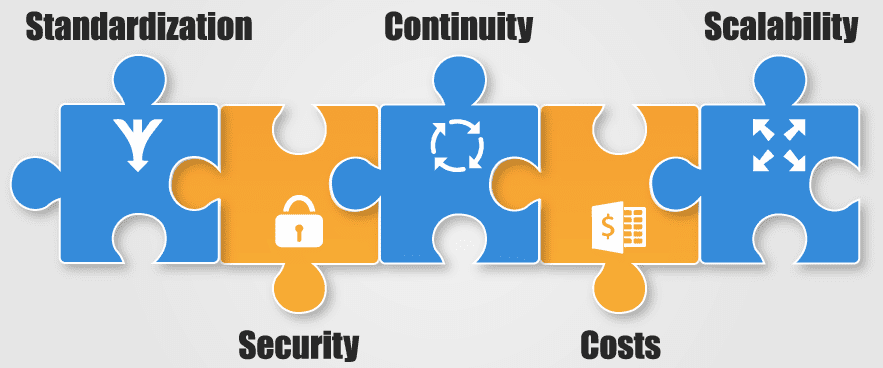How does an organization manage the IT assets that their business relies on? Do they have a methodical, proactive strategy in place or something more rudimentary and reactive? Most importantly, how can this strategy be used to add value to their business?
Asset Lifecycle Management (ALM) is the process of purchasing and managing an IT asset throughout each phase of its lifecycle, from its initial procurement to its final decommissioning. An IT asset is any type of hardware or software necessary to an IT operation (laptops, mobile devices, servers, etc.), and its life refers to its total period of functionality or ownership. Though ALM may seem like little more than an obligatory, routine procedure, there are several significant benefits organizations experience when they have an effective ALM strategy in place. As such, more and more companies are recognizing ALM as an indispensable component of an optimized IT strategy.

What Are the Benefits of Implementing an ALM Strategy?
There are several notable reasons why ALM has become increasingly essential to successful businesses. From streamlined daily operations to substantial cost benefits over time, organizations can expect to see some significant process improvements and more opportunities for scalability by implementing an effective ALM strategy.
Fortified IT Infrastructure
Assets that are improperly transferred, stored, imaged, or maintained can encounter performance deficiencies later on in their lives or have their periods of functionality cut short. A comprehensive, standardized ALM strategy, however, prevents these kinds of issues and maintains optimal asset performance levels by ensuring that an established setup procedure and regular maintenance and refresh schedule are in place. For example, having a dedicated data center ALM team to conduct regular hardware refreshes helps ensure that the leading data center technology is always being used. In addition, the ALM team monitors server performance with asset lifecycle reports to help keep their company attentive to performance levels.
Improved Network and Device Security
ALM increases visibility into the security levels of an organization’s assets. Through consistent security monitoring procedures, companies have more accurate insight into how well their practices meet information security compliance standards. An IT environment with poorly maintained equipment is not only inefficient, but also vulnerable. By establishing standardized timelines and procedures for the setup, maintenance, and decommissioning of assets, ALM helps prevent security breaches caused by obsolete, compromised, or inadequately installed hardware and software.
In the case of a data center, ALM facilitates the proper setup of a Network Operations Center (NOC) to ensure that data center activity is accurately monitored and secure information is thoroughly protected from potential exploitation later on. Outside of the data center, predetermined and documented protocols for collecting and decommissioning user assets enable efficient and secure data destruction to safeguard companies’ sensitive information. With more and more companies implementing “bring your own device” policies, ALM also maintains security levels throughout the organization and impedes network threats by ensuring that assets not owned by the company remain protected.
Enabled Business Scalability
Growing businesses require IT assets and asset management processes that not only scale with them, but also promote scalability. As such, effective ALM strategies are not only reactive, working to monitor and quickly resolve asset issues, but also proactive, helping to facilitate business growth. For example, data analysts work with ALM teams to ensure that their company purchases servers, switches, and load optimizers capable of handling the volume increases the analysts are tracking. These teams also collaborate to develop plans for purchasing and setting up new racks, or even whole new data centers, to accommodate business growth.
Moreover, Gartner estimates that 70 percent of businesses have a 30 percent discrepancy between their intended asset portfolio and their actual asset inventory.[i] With enhanced visibility into their asset portfolios, ALM plays a key role in a growing organizations’ asset management capabilities. An effective ALM strategy that meticulously tags, tracks, and maintains assets enables businesses who are planning an Initial Public Offering (IPO) to readily perform inventory counts across multiple locations around the globe. This consistent visibility into asset inventory is not only key for audit preparation, but also imperative for ensuring SOX compliance. ALM teams can also develop practices for mitigating asset waste, thereby reducing unnecessary asset purchases and creating cost savings that can help their organization scale. In this way, smart ALM empowers maintenance of IT assets so that organizations can stay ahead of the curve and proactively position their business for continued expansion.
Ensured Business Continuity
As IT assets continue to become more and more necessary to companies’ day-to-day functionality, consistently maintaining and optimizing them becomes equally important. Effective ALM works to prevent potential disruptions caused by improperly imaged or obsolete assets altogether so that daily business always runs smoothly. Developing a comprehensive plan for change management in a data center helps prevent potential loss of bandwidth and operating speed.
This plan might include ensuring that backup servers are properly installed before racks are switched out to avoid or reduce potentially lengthy network downtimes. In front-end offices, a proactive ALM strategy ensures employees receive hardware and software upgrades as soon as they’re needed and before they encounter technological hang-ups that disrupt their productivity. With reliable, optimized assets, employees are able to maintain consistent productivity levels.
Reduced Costs
Organizations with an effective ALM strategy are positioned for dramatic reductions in overhead costs. Indeed, Gartner estimates that businesses who execute an effective ALM strategy experience 30 percent cost savings in the first year of implementation and at least 5 percent cost savings in each of the following five years.[ii] ALM saves companies money by monitoring asset performance and ensuring that replacements for obsolete equipment are purchased before aging assets create business inefficiencies.
In the example of a data center, the risk of network downtime and disruptions to productivity—all of which result in massive costs to companies—is prevented or mitigated via strategic ALM. ALM also prevents loss of physical equipment, such as hard drives, with standardized tagging and space management procedures. In turn, this promotes increased visibility into organizations’ asset inventories, helping to avoid needless or redundant purchases later on. With assets consistently maintained and regularly updated, lifecycles are extended so that new equipment doesn’t need to be purchased as often, reducing assets’ total cost of ownership (TCO).
Determine the ALM Strategy That’s Right for Your Business
The scope of an ALM strategy might vary depending on a company’s unique goals. Regardless of scope or scale, however, more and more organizations are realizing the value of having an ALM strategy in place. Even if a company’s initial ALM strategy involves manually filling out a spreadsheet to keep track of asset inventory, it can be a critical step toward achieving process optimization and business growth. The significant benefits that ALM affords organizations are becoming increasingly indispensable as data centers evolve into hybrid environments, so explore what kind of ALM strategy your business needs to achieve its goals.
[i] IT Service Management: Asset Management Statistics & ROI Equations
[ii] IT Asset Management: It’s All About Process






